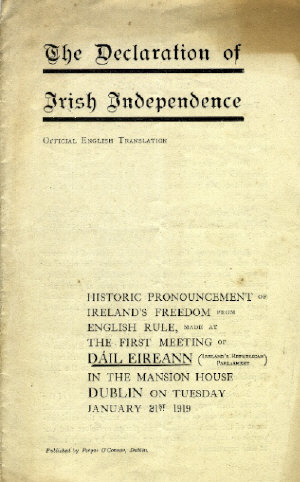Irish Declaration of Independence facts for kids
The Declaration of Independence (Irish: Forógra na Saoirse, French: Déclaration d'Indépendance) was a very important document. It was adopted by Dáil Éireann, which was the first parliament of the Irish Republic. This happened at their first meeting in the Mansion House, Dublin, on January 21, 1919.
This declaration came after the Sinn Féin political party's plan from December 1918. The Declaration of Independence was written in three languages: Irish, English, and French. It was a big step for Ireland to become an independent country.
Contents
What the Declaration Covered
The Irish Republic said it had power over the entire island of Ireland. The declaration talked about the independence of the "Irish nation" or "Irish people." It didn't specifically mention the 32 counties of the island.
The British government, led by the Lord Lieutenant of Ireland, did not agree with this declaration. But as the Irish War of Independence continued, more and more Irish people supported the Irish Republic. Later, in 1922, the Irish Free State was formed after the Anglo-Irish Treaty. This new state took over from the Irish Republic.
In terms of how countries recognize each other, this declaration met the rules for a country to declare itself independent. However, most countries at that time had different rules for recognizing new states. Because of this, almost no other countries recognized the Irish Republic in 1919.
Approving the 1916 Proclamation
With the Declaration of Independence, the Dáil officially approved an earlier statement. This was the Proclamation of the Irish Republic from Easter 1916. The 1916 proclamation was made by rebels during the Easter Rising. It was not made by an elected group.
But the Declaration of Independence was different. It was followed by the creation of real political groups and actions. A key part of the declaration said:
..we, the elected Representatives of the ancient Irish people in National Parliament assembled, do, in the name of the Irish nation, ratify the establishment of the Irish Republic and pledge ourselves and our people to make this declaration effective by every means at our command
This meant the elected leaders were confirming the Irish Republic. They promised to do everything they could to make it real.
Demanding British Troops Leave
The declaration also included a strong statement about British forces in Ireland:
We solemnly declare foreign government in Ireland to be an invasion of our national right which we will never tolerate, and we demand the evacuation of our country by the English Garrison.
The "English garrison" referred to the British soldiers and government in Ireland. This was the closest the Irish Republic came to declaring war on Britain in January 1919. They argued that Britain had invaded Ireland. Therefore, any military actions from then on were to remove the invaders.
The British government in London did not see this as a declaration of war. They thought it was mainly for an Irish audience. On the same day, the Irish War of Independence began with some unplanned shootings at Soloheadbeg, County Tipperary. The British treated these events as a police matter, not a war. The Irish Republican Army (IRA) did not officially promise loyalty to the Dáil until August 1920.
A History of Resistance
The declaration also looked back at Ireland's long history:
And Whereas for seven hundred years the Irish people has never ceased to repudiate and has repeatedly protested in arms against foreign usurpation.
This part meant that for 700 years, Irish people had fought against foreign control. This idea traced back to the 1160s, before the Anglo-Norman invasion of Ireland (1168–71). That was when Ireland was last fully free under Gaelic rule.
The declaration saw many past wars and rebellions as part of this ongoing fight. These included the 1594–1603, 1641–50, 1689–91, 1798, 1803, 1848, 1867, and 1916. All these were seen as attempts to regain Irish self-government.
Seeking World Recognition
A key goal of the 1918 Sinn Féin plan was to get other countries to recognize Ireland's independence. They hoped this would happen at the peace conference ending World War I.
We claim for our national independence the recognition and support of every free nation in the world, and we proclaim that independence to be a condition precedent to international peace hereafter:
President Woodrow Wilson of the United States had suggested that the Versailles Peace Conference would be fair to all. However, his "Fourteen Points" plan called for "equal weight" between parties in talks. It did not directly support outright declarations of independence.
In June 1920, a "Draft Treaty" between the new Russian Soviet Federative Socialist Republic and the Republic of Ireland was discussed. Historians believe that neither side took these talks very seriously. At that time, the Russian Soviet Republic was not recognized by many countries.
See also
On the same day the First Dáil adopted these other important documents:
- Dáil Constitution
- Message to the Free Nations of the World
- Democratic Programme


